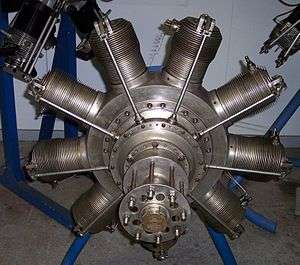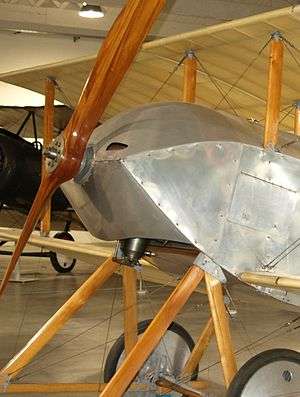Gnome Monosoupape
| Monosoupape | |
|---|---|
 | |
| A 1917 Gnome 9N 160 hp Monosoupape rotary engine, with dual ignition provision (twin spark plugs per cylinder) | |
| Type | Rotary aero engine |
| National origin | France |
| Manufacturer | Gnome et Rhône |
| First run | 1913 |
| Major applications | Avro 504 Sopwith Camel |
|
| |
The Monosoupape (French for single-valve), was a rotary engine design first introduced in 1913 by Gnome Engine Company (renamed Gnome et Rhône in 1915). It used a clever arrangement of internal transfer ports and a single pushrod-operated exhaust valve to replace a large number of moving parts found on more conventional rotary engines, and made the Monosoupape engines some of the most reliable of the era. British aircraft designer Thomas Sopwith described the Monosoupape as "one of the greatest single advances in aviation".[1]
Produced under license in both seven and nine-cylinder versions in large numbers in most industrialized countries including Germany (by Oberursel), Russia, Italy, Britain and the US. Two differing nine-cylinder versions were produced, the 100 CV 9B-2 and 160 CV 9N, with differing displacements and a dual ignition system on the later 9N version.
Background
Contrary to the Le Rhône designs, the early Gnome engines like the Gnome Omega, Lambda and Delta used a unique arrangement of valves in order to avoid needing pushrods and other complex devices that operated during the inlet phase of the combustion cycle on more conventional engines. Instead, a single exhaust valve on the cylinder head was operated by a pushrod that opened the valve when the pressure dropped at the end of the power stroke. A pressure-operated inlet valve, which was balanced by a counterweight to equalize the centrifugal forces, was placed in the centre of the piston crown, where it opened to allow the fuel–air charge to enter from the engine's central crankcase.
Although ingenious, the system had several drawbacks: the cylinder heads had to be removed both in order to perform maintenance of the intake valve, which could easily become jammed, and in order to adjust the timing and pressures correctly for the rod-less operation; and the Gnomes exhibited poorer fuel economy than other rotaries because the inlet valves could not be opened and closed at the ideal times.
Description
In 1913, Louis Seguin and his brother Laurent (engineers who founded the Société Des Moteurs Gnome [the Gnome motor company] in 1905) introduced the new Monosoupape series, which eliminated the inlet valve, replacing it with piston-controlled transfer ports similar to those found in a two-stroke engine. Beginning with the power stroke, the four-stroke engine operated normally until the piston was just about to reach the bottom of its stroke (bottom dead center, or BDC), when the exhaust valve was opened "early". This let the still-hot burnt combustion gases "pop" out of the engine while the piston was still moving down, relieving exhaust pressure and preventing exhaust gases from entering the crankcase. After a small additional amount of travel, the piston uncovered 36 small ports around the base of the cylinder, leading to the crankcase which held additional fuel–air mixture (the charge). No transfer took place at this point since there was no pressure differential; the cylinder was still open to the air and thus at ambient pressure. The overhead valve exhausted directly into the slipstream since no exhaust manifold could be practically fitted to the spinning crankcase and cylinders, partly in order to save weight and prevent excessive amounts of centrifugal forces in flight.
During the exhaust stroke, total scavenging occurred as the air moving past the cylinder exterior lowered the pressure inside due to the direct exposure of the exhaust port to the slipstream. The piston continued its exhaust stroke until top dead center (TDC) was reached, but the valve did not close. The piston began to move down on its intake stroke with the valve still open, pulling fresh (presumably un-filtered) air into the cylinder. It remained open until it was two-thirds of the way down, at which point the valve closed and the remainder of the intake stroke greatly reduced the air pressure. When the piston uncovered the transfer ports again, the low pressure in the cylinder drew in the balance of the charge.
The charge was an overly rich mixture of air, which was acquired through the hollow crankshaft, and fuel that was continuously injected by a fuel nozzle on the end of a fuel line, entering the crankcase through the hollow crankshaft. The nozzle was in the proximity of, and aimed at, the inside base of the cylinder where the transfer ports were located. The fuel nozzle was stationary with the crankshaft, and the cylinders rotated into position in turn. The compression stroke was conventional.
The spark plug was installed horizontally into the rear of the cylinder at the top but had no connecting high-voltage wire. An internal-tooth ring gear mounted on the engine drove a stationary magneto mounted on the firewall, whose high-voltage output terminal was in close proximity to the spark plug terminals as they passed by. This arrangement eliminated the need for distributor and high-voltage wiring found in conventional mechanically timed ignition systems. This ring gear also drove the oil pump, which supplied oil to all bearings, and through hollow pushrods to the rockers and valves and also drove an air pump which pressurized the fuel tank. The later, 160 CV Gnome 9N engines had dual ignition systems for safety, with twin spark plugs per cylinder which were electrically wired, with the wires routed onto the crankcase and a central pair of magnetos driven by the spinning engine crankcase.
Control
The Monosoupape had no carburetor or throttle, and since most of its air supply was taken in through the exhaust valve, it could not be controlled by adjusting the air supply to the crankcase like other rotaries. Monosoupapes therefore had a single petrol regulating control used for a limited degree of speed regulation. In early examples, engine speed could be controlled by varying the opening time and extent of the exhaust valves using levers acting on the valve tappet rollers, but this was later abandoned due to causing burning of the valves.[2] Instead, a blip switch was used, which cut out the ignition when pressed. This was used sparingly to avoid damaging the engine, since it was only safe to be used when the fuel supply was also cut. Some later Monosoupapes were fitted with a selector switch which allowed the pilot to cut out three or six cylinders instead of all nine when hitting the blip switch, so that each cylinder fired only once per three engine revolutions but the engine remained in perfect balance - the Fokker D.VIII reproductions that have flown, or are flying in the 21st century at Old Rhinebeck Aerodrome, all powered with restored Gnome Monosoupape 9N engines usually demonstrate this feature in ORA's weekend flight demonstrations.[2]
Lubrication

The lubrication system, as with all rotary engines, was a total-loss type in which castor oil was injected into the fuel–air mix with a small pump. Castor oil was used because it could not be easily dissolved into the fuel, and because it possessed lubrication qualities superior to mineral oils of the day. Over two gallons of castor oil were sprayed into the air during each hour of engine operation. This explains why most rotaries were fitted with a roughly 270° perimeter "horseshoe"-shape ring cowl, with the lowermost quarter of the cowl omitted to be open at the bottom. The cowl directed the spray of castor oil, along with sparks from the exhaust, away from the flammable aircraft structure.[3] Unburnt castor oil from the engine tended to be hurled into the pilot's face, often having a laxative effect on the pilot if ingested.[4]
Because the entire engine rotated, it had to be precisely balanced, requiring precision machining of all parts. As a result, Monosoupapes were extremely expensive to build, the 100 horsepower (75 kW) models costing $4,000 in 1916 (approx. $87,000 in 2014 dollars). However, they weighed slightly less than the earlier two-valve engines and also used less lubricating oil.[5]
Variants
- Gnome Monosoupape 7 Type A
- (1916) Seven-cylinder rotary engine, 80 hp (60 kW). Bore and stroke: 110 x 150 mm (4.3 x 5.9 in).
- Gnome Monosoupape 9 Type B-2
- (1916) Nine-cylinder rotary engine, 100 hp (75 kW). Bore and stroke: 110 x 150 mm (4.3 x 5.9 in). 2,188 units produced under license in Britain, with uprated 120 hp version later built in Russia/Soviet Union, two of which flew the Soviet TsAGI-1EA single lift-rotor helicopter in 1931-32.[6][7]
- Gnome Monosoupape 9 Type N
- (1917) Nine-cylinder rotary engine, larger diameter crankcase than the B-2, 150 or 160 hp (112 or 119 kW). Bore and stroke: 115 x 170 mm (4.5 x 6.7 in).
Applications
List from Lumsden.
Monosoupape 7
Monosoupape 9 Type B-2
|
|
Monosoupape 9 Type N
- Fokker D.VIII reproductions (late 20th - early 21st century)
- Nieuport 28C
- Sopwith F.1 Camel
- Morane-Saulnier AI
- Orenco B
Engines on display
- A nine-cylinder Monosoupape engine is on public display at the Royal Air Force Museum London.
- A seven-cylinder Monosoupape engine is on display at Solent Sky.
- One monosoupape built by Peter Hooker -England is on display at the Museo Nacional de Aeronáutica - Morón, Argentina. It is used during exhibitions to explain the rotary engines systems as it shows its operative internal parts.
- There is a restored B-2 Monosoupape on display at the New England Air Museum, Bradley Int'l Airport, Windsor Locks, CT, USA.[9]
- TAVAS in Australia have two. http://www.tavas.com.au/rotary-engine.php Both for exhibition in flying aircraft.
- A restored Monosoupape 9 Type N is on display in the Reynolds-Alberta Museum.
Specifications (Monosoupape 9 Type B-2)
Data from Lumsden.
General characteristics
- Type: 9-cylinder, single-row, rotary engine
- Bore: 110 mm (4.3 in)
- Stroke: 150 mm (5.9 in)
- Displacement: 12.8 L (781.63 cu in)
- Length: 107.4 cm (42.3 in)
- Diameter: 95 cm (37.4 in)
- Dry weight: 137.4 kg (303 lb)
Components
- Valvetrain: Single overhead valve with cylinder ports
- Fuel type: 40-50 Octane petrol
- Oil system: Total loss, castor oil
- Cooling system: Air-cooled
- Reduction gear: Direct drive, right-hand tractor, left-hand pusher
Performance
- Power output: 86 kW (115 hp) at 1,300 rpm (Maximum power)
- Compression ratio: 4.85:1
See also
- Gnome Omega, Delta and Lambda (earlier seven-cylinder Gnôme designs with inlet valve in piston crown)
- Comparable engines
- Related lists
References
Notes
- ↑ Nahum, Andrew (1999). The Rotary Aero Engine. NMSI Trading Ltd. ISBN 1-900747-12-X.
- ↑ fokker dviii old rhinebeck (YouTube). Old Rhinebeck Aerodrome: Mouraux Xavier. 15 September 2015. Event occurs at 0:27 to 1:00. Archived from the original (YouTube) on 15 September 2015. Retrieved 16 September 2016.
- ↑ Gnome Monosoupape Type N Rotary Retrieved on 18 February 2009.
- ↑ Setright, IJK (1971). The Power to Fly : The Development of the Piston Engine in Aviation. Allen and Unwin. p. 27. ISBN 978-0-04-338041-3.
- ↑ Vivian, E. Charles (2004). A History of Aeronautics. Kessinger Publishing. p. 255. ISBN 1-4191-0156-0.
- ↑ Savine, Alexandre. "TsAGI 1-EA." ctrl-c.liu.se, 24 March 1997. Retrieved 12 December 2010.
- ↑ video
- ↑ video
- ↑ http://neam.org/index.php?option=com_content&view=article&layout=edit&id=1103
- McCutcheon, Kimble D. "Gnome Monosoupape Type N Rotary" (PDF). Aircraft Engine Historical Society. Retrieved 2008-05-01.
Bibliography
- Lumsden, Alec. British Piston Engines and their Aircraft. Marlborough, Wiltshire: Airlife Publishing, 2003. ISBN 1-85310-294-6.
External links
| Wikimedia Commons has media related to Gnome Monosoupape. |
- Rattling of a Gnome engine
- Ground run of a rare 100 hp Monosoupape in Australia
- YouTube video of 100 hp Gnome Monosoupape demonstration
- Modern reproduction Fokker D VIII powered with 160 hp Gnome Monosoupape
- New Zealand-built (21st century) reproduction Type 9B-2 100 hp Monosoupape running